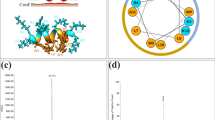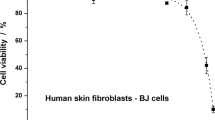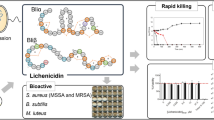Abstract
Warnericin RK from Staphylococcus warneri and PSMα from Staphylococcus epidermidis are anti-Legionella peptides which were differently classified in a previous study according to their mode of action. Indeed, warnericin RK is highly hemolytic with a bactericidal mode of action, whereas PSMα is poorly hemolytic with a bacteriostatic mode of action toward L. pneumophila. In order to find anti-Legionella peptides which are not hemolytic, a collection of peptides varying in sequence from warnericin RK to PSMα were designed and synthesized, and their anti-Legionella activities, in terms of growth inhibition, permeabilization, and bactericidal effect, as well as their hemolytic activities, were measured and compared. The results showed that some residues, at position 14 for both peptides for instance, were of major importance for bactericidal and hemolytic activities.


Similar content being viewed by others
References
Fields BS, Benson RF, Besser RE (2002) Legionella and Legionnaires’ disease: 25 years of investigation. Clin Microbiol Rev 15:506–526
Control ECfDPa (2014) Legionnaires’ disease surveillance in Europe, 2012. Stockholm: ECDC. http://ecdc.europa.eu/en/publications/Publications//legionnaires-disease-surveillance-2012.pdf. Accessed March 2014
Molmeret M, Bitar DM, Han L, Kwaik YA (2004) Cell biology of the intracellular infection by Legionella pneumophila. Microbes Infect 6:129–139
Borella P, Guerrieri E, Marchesi I, Bondi M, Messi P (2005) Water ecology of Legionella and protozoan: environmental and public health perspectives. Biotechnol Annu Rev 11:355–380
Thomas V, Bouchez T, Nicolas V, Robert S, Loret JF, Levi Y (2004) Amoebae in domestic water systems: resistance to disinfection treatments and implication in Legionella persistence. J Appl Microbiol 97:950–963
Marchand A, Verdon J, Lacombe C, Crapart S, Hechard Y, Berjeaud JM (2011) Anti-Legionella activity of staphylococcal hemolytic peptides. Peptides 32:845–851
Dinges MM, Orwin PM, Schlievert PM (2000) Exotoxins of Staphylococcus aureus. Clin Microbiol Rev 13:16–34 table of contents
Verdon J, Girardin N, Lacombe C, Berjeaud JM, Hechard Y (2009) delta-hemolysin, an update on a membrane-interacting peptide. Peptides 30:817–823
Hechard Y, Ferraz S, Bruneteau E, Steinert M, Berjeaud JM (2005) Isolation and characterization of a Staphylococcus warneri strain producing an anti-Legionella peptide. FEMS Microbiol Lett 252:19–23
Mehlin C, Headley CM, Klebanoff SJ (1999) An inflammatory polypeptide complex from Staphylococcus epidermidis: isolation and characterization. J Exp Med 189:907–918
Vuong C, Otto M (2002) Staphylococcus epidermidis infections. Microbes Infect 4:481–489
Yao Y, Sturdevant DE, Otto M (2005) Genomewide analysis of gene expression in Staphylococcus epidermidis biofilms: insights into the pathophysiology of S. epidermidis biofilms and the role of phenol-soluble modulins in formation of biofilms. J Infect Dis 191:289–298
Verdon J, Falge M, Maier E, Bruhn H, Steinert M, Faber C, Benz R, Hechard Y (2009) Detergent-like activity and alpha-helical structure of warnericin RK, an anti-Legionella peptide. Biophys J 97:1933–1940
Brogden KA (2005) Antimicrobial peptides: pore formers or metabolic inhibitors in bacteria? Nat Rev Microbiol 3:238–250
Yeaman MR, Yount NY (2003) Mechanisms of antimicrobial peptide action and resistance. Pharmacol Rev 55:27–55
Matsuzaki K, Murase O, Fujii N, Miyajima K (1996) An antimicrobial peptide, magainin 2, induced rapid flip-flop of phospholipids coupled with pore formation and peptide translocation. Biochemistry 35:11361–11368
Matsuzaki K, Sugishita K, Fujii N, Miyajima K (1995) Molecular basis for membrane selectivity of an antimicrobial peptide, magainin 2. Biochemistry 34:3423–3429
Pouny Y, Rapaport D, Mor A, Nicolas P, Shai Y (1992) Interaction of antimicrobial dermaseptin and its fluorescently labeled analogues with phospholipid membranes. Biochemistry 31:12416–12423
Bechinger B, Lohner K (2006) Detergent-like actions of linear amphipathic cationic antimicrobial peptides. Biochim Biophys Acta 1758:1529–1539
Verdon J, Berjeaud JM, Lacombe C, Hechard Y (2008) Characterization of anti-Legionella activity of warnericin RK and delta-lysin I from Staphylococcus warneri. Peptides 29:978–984
Alouf JE, Dufourcq J, Siffert O, Thiaudiere E, Geoffroy C (1989) Interaction of staphylococcal delta-toxin and synthetic analogues with erythrocytes and phospholipid vesicles. Biological and physical properties of the amphipathic peptides. Eur J Biochem 183:381–390
Dhople VM, Nagaraj R (2005) Conformation and activity of delta-lysin and its analogs. Peptides 26:217–225
Kerr ID, Dufourcq J, Rice JA, Fredkin DR, Sansom MS (1995) Ion channel formation by synthetic analogues of staphylococcal delta-toxin. Biochim Biophys Acta 1236:219–227
Matsuzaki K, Sugishita K, Harada M, Fujii N, Miyajima K (1997) Interactions of an antimicrobial peptide, magainin 2, with outer and inner membranes of gram-negative bacteria. Biochim Biophys Acta 1327:119–130
Tossi A, Sandri L, Giangaspero A (2000) Amphipathic, alpha-helical antimicrobial peptides. Biopolymers 55:4–30
Wimley WC, White SH (1996) Experimentally determined hydrophobicity scale for proteins at membrane interfaces. Nat Struct Biol 3:842–848
Bessalle R, Kapitkovsky A, Gorea A, Shalit I, Fridkin M (1990) All-D-magainin: chirality, antimicrobial activity and proteolytic resistance. FEBS Lett 274:151–155
Wade D, Boman A, Wahlin B, Drain CM, Andreu D, Boman HG, Merrifield RB (1990) All-D amino acid-containing channel-forming antibiotic peptides. Proc Natl Acad Sci USA 87:4761–4765
Dathe M, Meyer J, Beyermann M, Maul B, Hoischen C, Bienert M (2002) General aspects of peptide selectivity towards lipid bilayers and cell membranes studied by variation of the structural parameters of amphipathic helical model peptides. Biochim Biophys Acta 1558:171–186
Uematsu N, Matsuzaki K (2000) Polar angle as a determinant of amphipathic alpha-helix-lipid interactions: a model peptide study. Biophys J 79:2075–2083
Pokorny A, Almeida PF (2004) Kinetics of dye efflux and lipid flip-flop induced by delta-lysin in phosphatidylcholine vesicles and the mechanism of graded release by amphipathic, alpha-helical peptides. Biochemistry 43:8846–8857
Pokorny A, Birkbeck TH, Almeida PF (2002) Mechanism and kinetics of delta-lysin interaction with phospholipid vesicles. Biochemistry 41:11044–11056
Laabei M, Jamieson WD, Yang Y, van den Elsen J, Jenkins AT (2014) Investigating the lytic activity and structural properties of Staphylococcus aureus phenol soluble modulin (PSM) peptide toxins. Biochim Biophys Acta 1838:3153–3161. doi:10.1016/j.bbamem.2014.08.026
Eisenberg D, Schwarz E, Komaromy M, Wall R (1984) Analysis of membrane and surface protein sequences with the hydrophobic moment plot. J Mol Biol 179:125–142
Acknowledgments
A. Marchand was supported by a grant from the French Minister of Research. We thank Dr. Thierry Jouenne who provided the first synthetic peptides used in our study.
Author information
Authors and Affiliations
Corresponding author
Rights and permissions
About this article
Cite this article
Marchand, A., Augenstreich, J., Loiseau, C. et al. Effect of amino acid substitution in the staphylococcal peptides warnericin RK and PSMα on their anti-Legionella and hemolytic activities. Mol Cell Biochem 405, 159–167 (2015). https://doi.org/10.1007/s11010-015-2407-1
Received:
Accepted:
Published:
Issue Date:
DOI: https://doi.org/10.1007/s11010-015-2407-1




